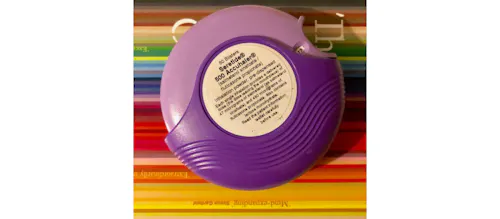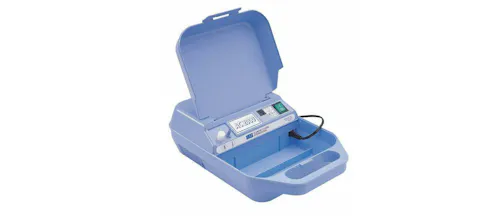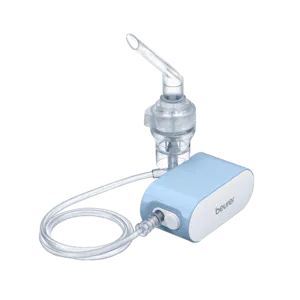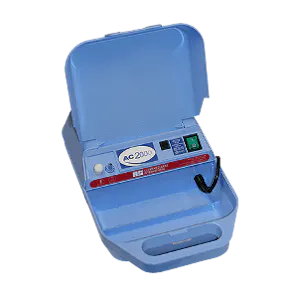What’s the difference between a nebuliser and an inhaler?
It’s a good question and one we still get asked several times a week. So, with apologies to those already in the know, let me explain.

Inhalers and nebulisers (sometimes spelled nebulizers) are two different devices used to deliver medications for chest conditions such as asthma, COPD, cystic fibrosis and other respiratory disorders. Inhalation enables drugs to be delivered directly to your lungs. The onset of action is rapid and lower doses can be given. They can be used for short acting or long acting medication as well as preventative and maintenance medication. Inhalers are available in the U.K. on prescription when recommended by your GP or respiratory professional and there are several different types.
Not all inhalers work the same way
Metered dose inhalers (MDI) are the most commonly prescribed and often referred to as 'puffers'. Like mini aerosol cans, these devices push out a pre-measured spray of medicine. When the user squeezes the inhaler, a measured 'puff' of medicine is released. MDIs require good coordination, breathing in at the same time as activating the inhaler, to achieve maximum drug delivery to the lungs. An incorrect technique will result in decreased delivery of the drug to the lungs and potentially reduce its effectiveness. Some MDIs have counters that indicate how many doses remain. If there’s no counter it’s important to track the number of doses used, so that the inhaler can be replaced on time.
'Breathe in normally' inhalers or Breath Actuated inhalers are normally given to people who are struggling with a standard 'puffer'. When you breathe in, it releases your medication in a fine mist without you having to push or squeeze a trigger. Or, if you’re struggling with coordination, your health professional may recommend an MDI with a spacer.
A spacer is a kind of holding chamber for the medicine which does away with the need to closely coordinate squeezing the inhaler and inhaling the medicine. With an inhaler and spacer, the medicine can be inhaled slowly when the user is ready. Spacers also help to reduce local side-effects, such as dysphonia (a hoarse voice) or candidiasis (oral thrush) from inhaled corticosteroids.
Dry powder inhalers deliver medicine in a fine powder form, but they don’t spray out. You must do more of the work, inhaling the powdered medicine quickly and quite forcefully.
Nebulisers
A nebuliser is an electric or battery powered machine that turns liquid medicine into a fine mist that you can inhale into your lungs. You breathe in the mist through a mouthpiece or face mask. Nebulisers vary in size and shape and it’s important to choose the device that suits your medication and fits into your lifestyle.
You may need a nebuliser in an emergency, if you are struggling to breathe and need a high dose of your reliever medicine or if you need antibiotics to treat an infection. Your respiratory professional may recommend a nebuliser for you at home if your condition is very severe, and inhalers are not as effective or if you can’t use an inhaler because of another health condition, such as arthritis. Nebulisers are also occasionally used for babies and very small children.
There are many different types of nebuliser
The most often seen nebuliser is a mains powered compressor device. Sometimes described as a jet nebuliser. If your healthcare professional agrees that you need a nebuliser and is happy to supply the medication be sure to get one from a reputable manufacturer. If you only nebulise occasionally you don’t have to overspend. However if you nebulise more frequently and possibly use multiple nebules, spending a little more could be cost effective. Nebulising an antibiotic should be done through a 'closed system'.
Portable nebulisers
Being recommended a nebuliser doesn’t mean being stuck at home. Portable nebulisers are these days much more effective and efficient. Compressor type nebulisers such as the Beurer IH60 are really versatile. You can use it from its built in rechargeable battery it can be recharged via its USB port in the car or from the mains.
Mesh nebulisers work with a different type of technology, they are tiny and virtually silent. The mesh is a small metal plate with 6,000 microscopic holes which the medication is pushed through, at speed, to form a visible mist. This vibrating mesh technology allows your medication to penetrate quickly and deeply into your lungs. They can operate from shop bought batteries such as the Omron U100 and Pari Velox, or come with a rechargeable battery like the Beurer IH57. Mesh nebulisers aren’t suitable for enzymes or antibiotics and if you're not sure whether they'd be right for you have a look at this blog post or get in touch.
Ultrasonic nebulisers use a piezoelectric crystal vibrating at high frequency to create the aerosol. The vibrations are transmitted through a buffer to the drug solution (usually water) and form a fountain of liquid in the nebulisation chamber. Ultrasonic nebulisers produce a more uniform particle size than jet nebulisers, but are less widely used due to cost.
Which nebuliser should I choose?
Another question we frequently get asked and it’s why we write this blog. Nebulisers for you to use at home, to take on your travels, one suitable for your mum, or perfect for your medication, all the answers and more can be found in these pages. Our website is easy to navigate and you can get in touch by email or phone. So when the time comes, don’t worry, once you’ve spoken to your respiratory professional we’re here to make sure you choose the right device to match all your needs.
We supply models from the following reputable manufacturers.
So why not give us a call?
Photo credits: Emily Morter













